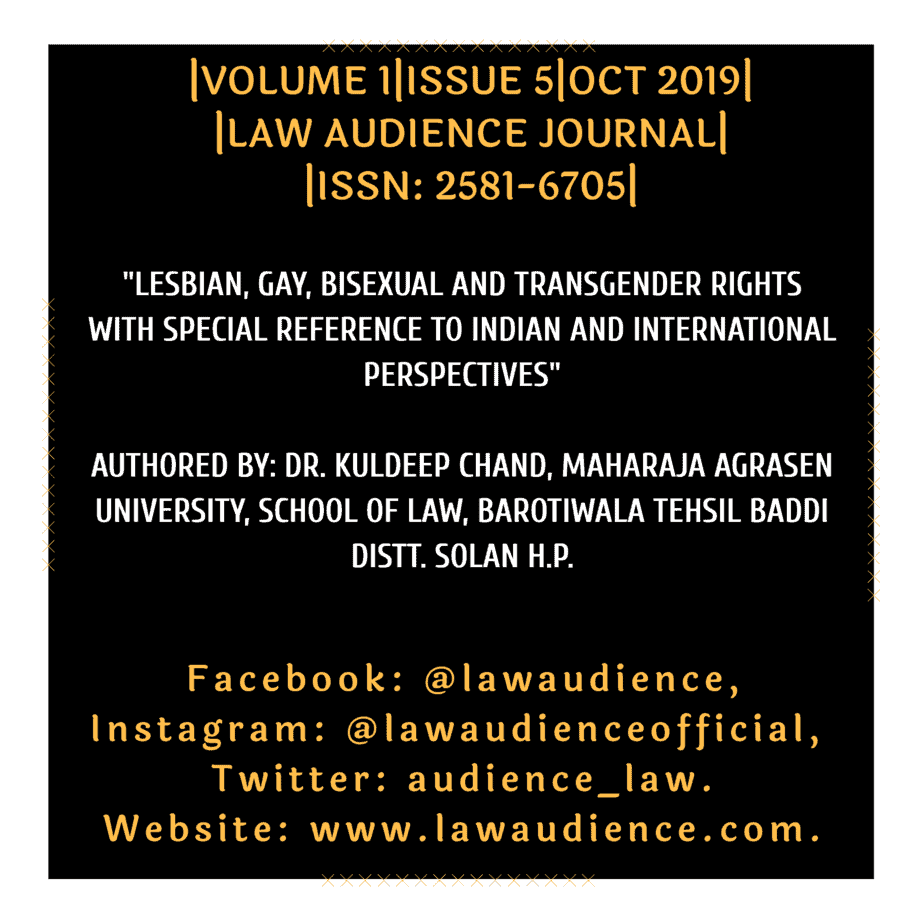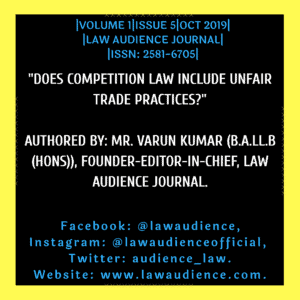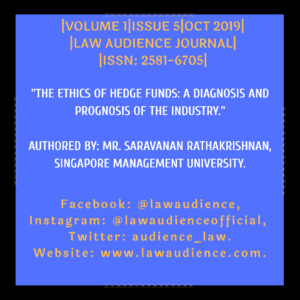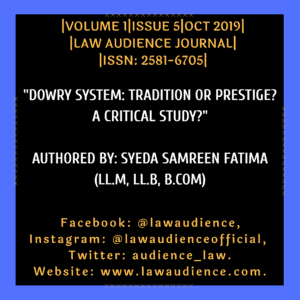Authored By: Dr. Kuldeep Chand, Maharaja Agrasen University, School of Law, Barotiwala Tehsil Baddi Distt. Solan H.P.
I. INTRODUCTION:
Human relationships are recognised by complex human society. In a society, there is an organized way of human structure in which every human being played the role according to the rules and regulations made by the society from the very beginning. People interact with each other according to the structural behaviour of the surroundings and the people they met. Their performance of the role depends upon the conditions of the status they occupy in the community or the civilization in which they took birth. The most basic criteria for defining the status in which they perform their role as an individual personality in society have been sex. According to which men have been assigned to perform the role which are of specific nature and women are assigned certain other specific work to do in the society on the bases of their sex. Sometimes society wants both men and women to perform the roles which are to be done jointly or homogeneous nature in one way or the other.
So, these types of performances can be seen as the general case of the role performance in which men and women act according to the norms of the society in which there is no objection and curiosity by the people as it will be considered normal and not beyond the rules of the community in which they belong. However in a rare, situation one can observe that some people perform their role normally but the performer of that role by behaving in the manner which is not acceptable in the society creates the sight of an unusual situation and becomes the piece of curiosity by the observer in the society in one way or the other.[1] These Lesbian, Gay, Bisexual and Transgender people are living in the shadow of the anti-sodomy law which is generally done by these people as their normal nature of sex but because of the norms of the society they are generally out graded from the Indian society which is best known for its democracy where all people enjoys equal rights, have the right to vote and are treated equally. Presently, it has been seen that many homosexual as well as heterosexual people are coming forward to fight for their rights and to make the Government realise that they also exist in the society and must have equal rights and opportunities as that of normal people which are living with them in the community but are not accepting them with an open arms as they are afraid of the rules which are made for them to follow.
So, these communities have the mixed feeling that they are sometimes accepted in the society whenever there is need of them to perform something like transgender went to the house whenever there is a celebration of the childbirth and after the need stops, automatically they are being discarded from the society.[2]
II. HISTORICAL BACKGROUND OF LESBIAN, GAY, BISEXUAL AND TRANSGENDERS:
Homosexuality in India is very common in the ancient period as it is no taken as a taboo at that time. It is in the present time that these people have to fight for their rights to be recognized in the country and to be accepted in the society peacefully. In Ancient India, homosexuality was traced back in 1500 BC at the time of Rig-Veda. The detailed acts of the homosexuals in the Kama Sutras, in the Mughal period keeping of boys by the Muslims in harems for their pleasure, Tantric rituals are also performed with the male persons to get the maximum benefits are the few examples in which male homosexuals are involved back in the date of the ancient period.[3]
There is one common story on Mahabharata where Shikhandi who is a woman but raised as men defeated Bhishma Pitmah in the battlefield of Kurushetra. In Hindu Mythology, Hindu God Shiva is also seen as Ardhanarisvara with nature of both male and female, in which right side is male and left side is female.[4] Manu Smriti in 200 BC-200 AD explains the biology of three sexes in which when the male child is produced it is because of the greater quantity of male seed whereas when the female child is produced it is because of the greater quantity of the female seed. But, when the male and female seed both are equal, a third sex child or boy and girl twins are produced. If the seeds are weaker or not in a good quantity of both male and female then a failure of conception results.[5]
III. DEFINING LESBIAN, GAY, BISEXUAL AND TRANSGENDER:
Lesbians:
Are those female homosexuals in whom one female plays an active role of a male. These are the women who got attracted to other women sexually or romantically. It is like same-sex attraction.
Gay:
Are homosexuals males in which, both are males and out of which one male plays the role of a female. It is like same-sex attraction between two persons and not to the opposite sex.
Bisexual:
People are those who indulge in sexual activities with males and as well as females. They have the characteristics of both sexes in which they are sexually attracted to both men and women.
Transgenders:
Are the phenomena in which being a person (as transsexual or transvestites) who identifies with or expresses a gender identity are different from the one which corresponds to the person’s sex at birth.[6] They are also referred sometimes with various names like Hijras, Aravanis, Kothi, Jogtas and Shiv-Shakti.
The Hermaphrodite is also used for all those persons who have both male and female organs. There is conflict among these words as there are sections who says that the word hermaphrodite implies to the person who are fully male and fully female both, whereas some medical practitioners say that the hermaphrodite can be used for all those persons who have both male and female organs, but they are not capable of reproduction and from these things, all the intersex people are hermaphrodites, whereas LGBTs are called as pseudo-hermaphrodite. People with a syndrome known as Klinefelter have an extra X-chromosome either from their father or their mother, which results in an XXY-chromosome instead of XY chromosome.
Klinefelter is common, whereas Turner syndrome is a type of chromosomal genetic syndrome with one X chromosome and no second chromosome i.e., X or Y. In a person with Turner syndrome, female sex characteristics are usually present, but underdeveloped compared to the typical female. In Indian Vedic civilization, a person who born without the proper development of sex organs were called as ‘Nisarga’ in Sanskrit and which had a chronic physical condition caused by the biological combination of the male and female sexes known as intersexual.[7] So, intersex people are mainly those persons who are born with sex characteristics which do not fit to their notion of male or female bodies. This term is widely used in the umbrella term as it makes the difference between the other general terms of lesbians, gay, bisexual and transgender people.
IV. INTERNATIONAL PROVISIONS FOR LGBT:
There are many provisions regarding the support for the LGBT people around the world. Most of the countries located in America and Western Europe approved same-sex marriages. But still, there are countries which do not have firm laws regarding these people and have come in a neutral way. But, the United Nation has also contributed a lot regarding the rights of the LGBT community
i. International Bills of Gender Rights 1996:
It establishes the right to self-determination of one’s gender identity and to medical care which allows the individual to realise this. It includes the right of free expression of gender identity,[8] Right to control and change one’s own body[9] and Right to competent Medical care and professionals.[10]
ii. Universal Declaration of Human Rights, 1948:
In the declaration of Human Rights, it is clearly stated that all persons are born free and equal in dignity and rights.[11] Everyone is entitled to all the rights and freedoms set forth in this Declaration, without distinction of any kind, such as race, colour, sex, language, religion, political or other opinion, national or social origin, property, birth or other status.[12] Everyone has the right to life, liberty and security of person.[13] Everyone has the right to recognition everywhere as a person before the law.[14] All are equal before the law and are entitled without any discrimination to equal protection of the law. All are entitled to equal protection against any discrimination in violation of this Declaration and against any incitement to such discrimination.[15] From all these rights we can see that there is equality everywhere regarding the people and it includes the rights of LGBT people also.
iii. European Convention on Human Rights, 1950:
In this convention, it is clearly stated that everyone has the right to life and it shall be protected by law. No one shall be deprived of his life intentionally save in the execution of a sentence of a Court following his conviction of a crime for which this penalty is provided by law. Deprivation of life shall not be regarded in the article when it results from the use of force which is no more than absolutely necessary in defence of any person from unlawful violence, in order to effect a lawful arrest or to prevent the escape of a person lawfully detained, in action lawfully taken for the purpose of quelling a riot or insurrection.[16] No one shall be subjected to torture or to inhuman or degrading treatment or punishment.[17] Everyone has the right to liberty and security of person. No one shall be deprived of his liberty in accordance with a procedure prescribed or established by law.[18] The enjoyment of the rights and freedoms which are given in this Convention shall be secured without discrimination on any ground such as sex, race, colour, language, religion, political or other opinion, national or social origin, association with a national minority, property, birth or other status.[19]
V. LEGISLATIVE PROVISIONS IN INDIA:
Although, in India, there is no specific law which directly describes the rights of LGBT people still there are some rights which are applied to them. There are still pending bills in the House of Parliament regarding the protection of these community but there is a hope for them that the bill will become an Act one day and all the rights are given to them equally.
i. Immoral Traffic Prevention Act of 1956:
This Act was amended in 1986 has become gender-neutral legislation. The domain of the Act now applies to both male and female sex workers along with those whose gender identity was indeterminate.
ii. Constitution of India:
Article 14 of the constitution states that the State shall not deny to any person equality before the law or the equal protection of the laws within the territory of India.[20] Article 15 provides for the Prohibition of discrimination on grounds of religion, race, caste, sex or place of birth.[21] Article 16 provides for Equality of opportunity in matters of public employment.[22] Article21 deals with the protection of life and personal liberty. It states that no person shall be deprived of his life or personal liberty except according to the procedure established by law.[23]
iii. National Legal Service Authority vs. Union of India[24]:
In this case, the Supreme Court gave legal recognition to the Transgender to be considered as the third gender as legally recognized apart from the male and female in the country. But in this case, there is an issue regarding the rights of the Lesbians, Gays and Bisexual people that whether they are included in this decision or not because of the specific acknowledgement of the Transgenders in India. Although, Justice Radhakrishnan and A.K. Sikri mentioned in their judgement in the point 19 and 20 by including the definition of ‘gender identity’ and ‘sexual orientation’ in which Gender Identity refers to the term in which each person felt internal and individual expression of gender which may or may not corresponds with the sex assigned to them at birth. It, therefore, refers to an individual’s self-identification as a man, woman, transgender and other identified category. On the other hand, Sexual Orientation refers to an individual who attains physical, romantic and emotional attraction to another person. From this point of difference, we can easily see that the LGBT people are included by the Supreme Court but it creates confusion among the people regarding their existence.[25]
iv. Navtej Singh Johar & Ors vs. Union of India[26]:
The Hon’ble Supreme Court of India on 6th Sep 2018 gave a landmark judgement on Section 377 of Indian Penal Code. In this case, the Court held that:
“History owes an apology to the members of this community and their families, for the delay in providing redressal for the ignominy and ostracism that they have suffered through the centuries. The members of this community were compelled to live a life full of fear of reprisal and persecution. This was on account of the ignorance of the majority to recognise that homosexuality is a completely natural condition, part of a range of human sexuality. The mis-application of this provision denied them the Fundamental Right to equality guaranteed by Article 14. It infringed the Fundamental Right to non-discrimination under Article 15, and the Fundamental Right to live a life of dignity and privacy guaranteed by Article. The LGBT persons deserve to live a life unshackled from the shadow of being ‘unapprehended felons’. In view of the aforesaid findings, it is declared that insofar as Section 377 criminalises consensual sexual acts of adults (i.e. persons above the age of 18 years who are competent to consent) in private, is violative of Articles 14, 15, 19, and 21 of the Constitution. It is, however, clarified that such consent must be free consent, which is completely voluntary in nature, and devoid of any duress or coercion.”
VI. CONCLUSION:
Thus, from the above discussion, it can be analysed that LGBT’s are not given as much respect as they needed in society but still they play an important role in our life. One of the main examples which are present today is that of marriages, childbirth in which Hijras came and shower blessings to the family, take their badhai and just gone. In Indian society, LGBT are seen as a stigma because they act in a way which is opposite to their nature and beyond the rules and regulations of the society and all those persons who act opposite to their nature are not acceptable in society whether it is a man or woman or anyone. LGBT people face many social, legal as well as economic difficulties. The main problem with them is with their family, just because their birth is not according to their nature, their family members exclude them and in the case of transgenders, they have been given to the Hijras community to where they belong in majority cases.
Although, they do not want to in some rare cases give their child but due to the pressure of the society and brainwashing of the family by their relatives, neighbours and wherever they go, the family have to take this step. But, if a child starts behaving in a way that is inappropriate or which is exactly opposite to their gender role then it is very difficult for the parents to digest it and the main thing they do in most cases is to exclude their child and not accept them in the way they are. It is one of the examples for the discrimination of LGBT in society.
The Supreme Court decision regarding the NALSA case is already creating much confusion among the LGBT for their Hindu’s right of interest. United Nation Human Right Council have also voted on setting up of the office in which independent expert will be there to handle the cases and gave advice on the matters relating to the social discrimination which is the main problem in India as well as all over the world for the community of LGBT rights and legal recognition.
[1] S.K. Sinha Hijras: The Labelled Deviants, pp.1-2 (2009).
[2]www.queer-ink.comlast accessed on 27-9-17 at about 10:40 A.M.
[3] Available at www.shodhganga.inflibnet.ac.in last accessed on 11-02-18 at about 11:56A.M.
[4]Devdutt Pattanaik, Shikhandi and others tales they don’t tell you, pp.172-173 (2014).
[5] Manu Smriti, The Laws of Manu, Chapter 3 edited by G. Buhler. 13 (1886).
[6] Available at www.undp.org last accessed on 11-02-18 at about 12:08 P.M..
[7]Mandeep Verma, Saleena, AnkushSharma, Problems of God’s Own Creation, Vol 48, C&MLJ, pp.113-114 (2012); See also Modi’s Medical Jurisprudence and Toxicology (1999).
[8] International Bill of Gender Rights, 1996, Point 2.
[9] Id., Point 5.
[10] Id., Point 6.
[11]See, Universal Declaration of Human Rights, 1948, Art 1.
[12]Id., Art. 2.
[13]Id., Art. 3.
[14]Id., Art. 6.
[15] Id., Art. 7.
[16]See, The European Convention on Human Rights 1950, Art. 2.
[17] Id., Art. 3.
[18] Id., Art. 5.
[19] Id., Art. 14.
[20] See, The Constitution of India, Art. 14.
[21]Id., Art. 15.
[22] Id., Art.16.
[23] Id., Art. 21.
[24] (2014) 5 SCC 438.
[25] Available at www.wire.in, last accessed on 11-02-18 at about 06:38P.M..
[26] WRIT PETITION (CRIMINAL) NO. 76 OF 2016.



